Application of a lever and a wheel and axle to get a car out of a frozen lake.
Tag: simple machines
Choosing Their own Work
One of my students asked me, “Can we spend next week working on our machine?” And I said yes.

This was a week and a half ago. I’d planned on to starting the discussion of conservation of energy as we transition from mechanical to thermal and electrical energy. However, I find it hard to resist when students ask to pursue an area of work. Students learn a lot more when they’re intrinsically motivated.
So, after the request to continue working on the machines I did an informal survey to see if the rest of the class were interested. They were quite interested, and the vast majority really wanted to continue on their projects — or something similar — rather than just having an opportunity to slack off.
I, therefore, let them have the time. My only requirement was that they state an objective for the week.
One group’s goal was to build a complex machine with 500x mechanical advantage. Another student — I let them choose their own groups or work alone — simply wanted to build a working pulley system; something he been having trouble with all month. A couple of other groups wanted to build robot projects.
And they went at it. All week long students would come into class eager to work. On Wednesday I got back into the science room a few minutes late for class, and they were all in there working away. It is a wonderful thing to be able to walk into a classroom with the whole class on-task and combining their new knowledge with their creativity.
Of course, after the first few days the projects evolved. I gave one group a Lego microcontroller and a quick lesson to help them activate the second part of their pulley system.
Another group quickly finished their robot and wanted some sort of track that it could follow. I did not have a track, but digging around in the store-room uncovered our track building kit — one of the ones with loops and jumps that’s great for learning about inertia, and conservation of energy. I also helped them out by giving them a fire pit (with green flames) for their marble to jump.
In retrospect, I realize that I should also have had them keep a daily diary of their work — I had to settle for summary at the end of the week instead — but they did some really exciting, self-directed work that I was really proud to see.
Steam Powered Sawmill (at the Deutsch Country Days)

A couple weekends ago, I took my kids to see the Deutsch Country Days. It’s one weekend each year where they set up a 19th century German immigrant village in Marthasville just east of St. Louis. They make cider, cheese, candles, rope, tin ornaments, and a lot more on the spot. You can see the wonderful household mechanisms in old log cabins and watch blacksmiths at work. But my favorite part had to be the sawmill where they were cutting large logs using a large, ~75cm, diameter blade powered by an actual steam engine.
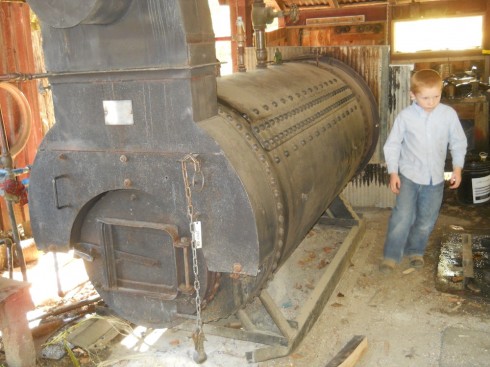
The big boiler pipes steam into the engine which turns a wheel and axle, which drives a large belt, which connects via another wheel and axle to the large blade. It’s a nice example of a complex machine, which the middle schoolers have been discussing in class.
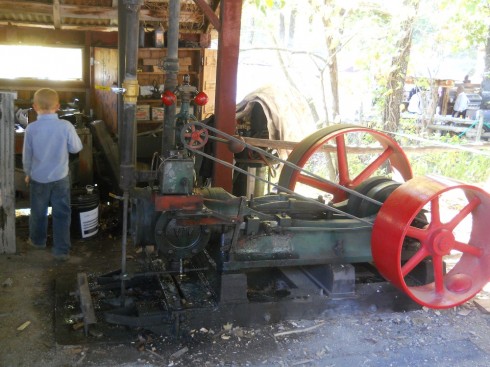

It was a great way to spend a wonderful fall day.
Hedge Clippers as a Combination of Two Simple Machines
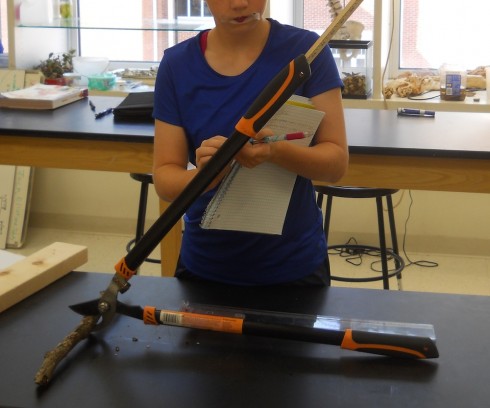
Now that we’ve studied simple machines, we’re practicing by calculating the mechanical advantage of some of the complex machines students have around the school. The clippers my outdoor group uses every Friday, for example, are a combination of a lever (the arms) and a wedge (the blade).
For levers the mechanical advantage (M.A.) is:
![]()
which in this case is measured as the distance from the bolt that the arms pivot about to the handholds (for the input force) and the stick (for the output force):
![]()
The wedge is an inclined plane, and its mechanical advantage is:
![]()
which we calculated to be about 3.
![]()
Combined, the two mechanical advantages multiply each other to give a total mechanical advantage of 36, which means that any force you apply to the handles of the clippers gets multiplied 36 times to the thing you’re trying to cut.
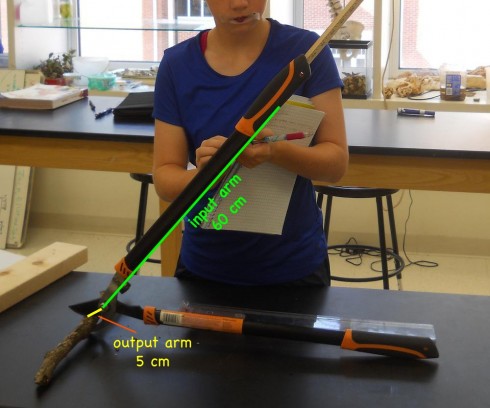
Taking Down the Wall
Becoming Da Vinci
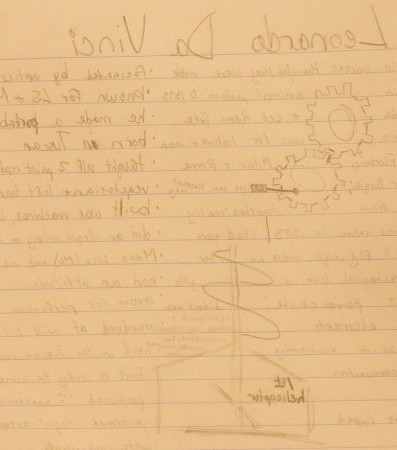
Working models of Leonardo Da Vinci’s devices, and video of his sketchbook, so inspired one student that she emulated Da Vinci’s style as she took her notes during our visit to the Da Vinci Machines Exhibition. While I’d asked them to bring their notebooks, I’d not said anything about taking notes (nor is there to be a quiz afterward) so it was very nice to see this student’s efforts. The exhibition is in St. Louis at the moment, until the end of the year.
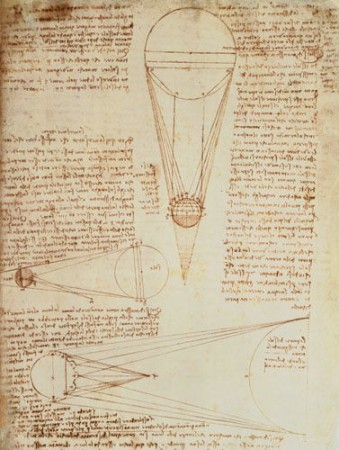
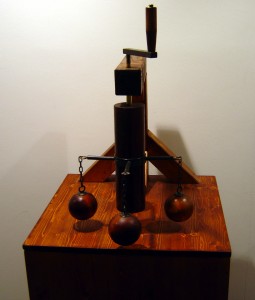
What I liked most about the exhibit is that you can operate some of the reconstructions of flywheels, gears, pulleys, catapults, and other machines that came out of DaVinci’s notebooks.
Da Vinci did a lot with gears, inclined planes, pulleys and other combination of simple machines, so the exhibit is a nice introduction to mechanics in physics. The exhibition provides a teacher’s guide that’s useful in this regard.
It’s an excellent exhibition, especially if you spend some time playing with the machines.
Physics and history in Vicksburg, MS.

Four hours away, Vicksburg, MS. is just within reach for an immersion trip so, since we were in the area, I scoped it out for a future trip. Vicksburg was the final town to fall before the Union could control the Mississippi River and split the Confederacy into two, so it’s historically important. The Vicksburg National Military Park is chock full of monuments and markers that give a good idea about the chaos and carnage of the battle for the town, and even a chance to observe practical application of simple machines and steam engines.
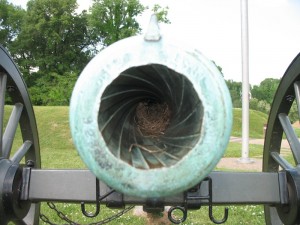
The park could complement Shiloh and Corinth quite nicely since Vicksburg’s importance was because of its control of transportation routes, just like with Corinth. It also has the salvage of the USS Cairo, an ironclad sunk during the Civil War. Much of he Hull is still missing so it’s a wonderful chance to see all the mechanisms and engines in a steam powered ship.
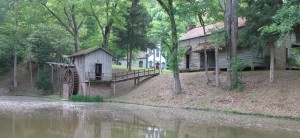
What I found most interesting, however, were the old watermill and farming equipment at Grand Gulf Military Park, about 45 minutes south of Vicksburg. They seem almost in working order, and if you’ve been discussing simple machines, as we have, it’s a great opportunity to see how they were applied in real-life.
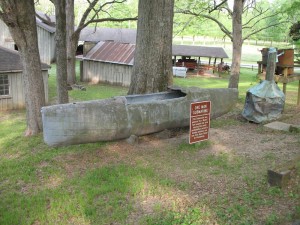
The watermill is quite picturesque, making it a great subject for sketching or drawing. I like to combine art and science in this way when possible. Grand Gulf also has a small, submarine used by bootleggers during prohibition which is quite the curious piece of engineering.
[googleMap name=”Grand Gulf Military State Park” description=”Watermill and camping” width=”400″ height=”300″ mapzoom=”8″ mousewheel=”false”]12006 Grand Gulf Rd, Port Gibson, MS[/googleMap]
